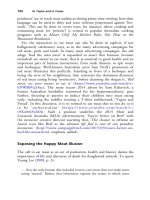The palgrave international handbook of a 246
Bạn đang xem bản rút gọn của tài liệu. Xem và tải ngay bản đầy đủ của tài liệu tại đây (26.95 KB, 1 trang )
International Trade in Animals and Animal Parts
241
Justice 2015). Likewise, the farming of captive-bred tigers and bears, as
discussed above, is practiced as a contentious alternative to killing wild
populations (IFAW 2006).
Conclusion
Clearly, IWT threatens the survival of some species. Yet, perhaps more
significantly, in terms of the focus of this chapter, the wildlife ‘utilised’ in
both the legal and illegal trade are forced to endure individual and institutionalised abuse. Though estimates of scale have been provided here, these
must be considered with caution as they are highly imprecise and difficult to
measure, as Regueira and Bernard (2012) note. We do know that the IWT
happens essentially everywhere and that it costs numerous animals their lives:
for each wild animal traded alive, 3 (Redford 1992) to 10 (RENCTAS 2001)
others may have died. Illegal trade conditions are frequently degrading:
animals are caged in overcrowded compartments, without water and food,
and suffer stress, fights, mutilations and death (RENCTAS 2001) or a
significant reduction in life expectancy (Vanstreels et al. 2010). The interconnected nature of this damage makes this a transnational crime in that it
harms more than the individuals directly in contact with it. For example, the
removal of such a high number of individuals from their habitat can lead to
species extinctions and compromise several ecological services (for example,
pollination, seed dispersal, and control of populations of other animals)
(Regueira and Bernard 2012). The routine abuse, suffering and death all
provide profound evidence of the victimisation of animals within the legal
and illegal wildlife trade. Wyatt (2013c) argues there is not a single case of
wildlife trade where an animal has not suffered in some fashion. Being
captured, smuggled, possibly dying, or living a life in pain and/or confinement (even possibly after being ‘rescued’ from the trade) are all forms of
animal abuse.
As with other types of animal abuse, offenders in the IWT vary considerably in terms of demographics and background, and there is no simple or
definitive answer as to what motivates them (Wyatt 2013c). Offender types
and motivations are rarely discrete; typically, they overlap and are influenced
by both macro and micro factors. Rational choice theory highlights that IWT
offenders motivated to secure significant financial reward can do so with little
cost, risk or concern for welfare. However, it is also crucial to understand the
broader social norms (Von Essen et al. 2014), facilitated by speciesism and
anthropocentric interests, which allow individuals to ignore or reject the









